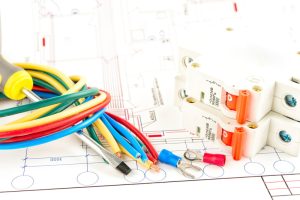If you don’t have an immediate answer to this question, don’t worry. Many people aren’t aware of the type of wiring they have in their homes or how to describe it. But it’s an important question to ask yourself and get an answer to, because you don’t want outdated wiring in your home.
If you have older wiring that will have difficulty handling current electrical loads or which can create safety hazards, you’ll definitely want to work with us for electrical rewiring in Hart County, GA.
The Problem With Aluminum Wiring
Aluminum wiring was widely used in the 1960s and 1970s as a cheaper alternative to copper. It has since been found to pose several safety risks. Key issues include oxidation and corrosion at connection points, increased brittleness over time, and higher thermal expansion rates compared to copper. This can lead to loose connections, increased electrical resistance, and ultimately, a higher risk of overheating and fires. Aluminum wiring also requires special connectors and devices to ensure safe connections—and these are often ignored, leading to additional safety concerns.
The Problem With Knob and Tube Wiring
Knob and tube (K&T) wiring was common in homes from the late 1800s to the mid-20th century, but it’s now considered outdated and hazardous. This type of wiring lacks grounding, has insulation that degrades over time, and often can’t handle modern electrical loads. These factors create an increased risk of electrical shocks, short circuits, and fires. Additionally, many K&T systems have been improperly modified over the years, further compromising their safety.
Why Copper Wiring Is the Moden Choice
Copper wiring first started to become a widespread wiring option after World War II, and became the dominant wiring type with the end of the 1980s. Copper wiring is considered the best modern choice for homes because of its excellent electrical conductivity and durability. Copper’s low electrical resistance means it can efficiently carry more current than other materials, reducing the risk of overheating and electrical fires. This high conductivity ensures that electrical systems run smoothly and reliably, providing consistent power to household appliances and devices. Additionally, copper is highly ductile and can be easily bent or twisted without breaking, making it ideal for complex wiring installations where flexibility is crucial.
Unlike aluminum, copper doesn’t significantly expand when it heats up, which reduces the chance of loose connections over time. Its natural resistance to corrosion and oxidation ensures that connections remain secure and efficient, further enhancing safety.
How to Know What Kind of Wiring You Have
The information above may have already told you what type of wiring you have just based on your home’s age. If your house was built later than the 1980s, you almost certainly have copper wiring. If it was built in the 1960-70s, there’s a possibility of aluminum wiring. And if your house is truly vintage, it may have K&T wiring. We strongly recommend you arrange for an electrical audit with us if you have suspicions about your home’s wiring. We can determine if you need any amount of rewiring.
Contact JN Electrical Temperature Control, Inc. and you’ll “Feel the Difference”!


